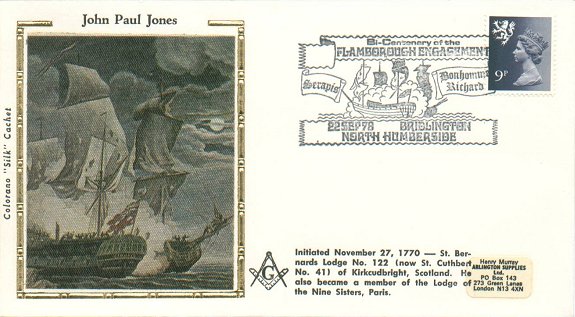John Paul
Jones
Father
of the American Navy - Masonic FDC

John Paul
Jones (1747-1792) Father of the American Navy. His original
name was John Paul. Born July 6, 1747 in Kirkbean, Scotland. He went
to sea at the age of 12, and at 19 was first mate of a slaver, and captain of a
merchantman three years later. Ill fortune struck, however, when a man,
flogged on his ship, died and another was killed in a mutiny. Hostile
witnesses at the inquiry made it rough for him and he next appeared at his
brother's home in Fredericksburg, Virginia, having added the alias of "Jones" to
his name. He had been made a member of St. Bernards Lodge No. 122 (now St.
Cuthbert No. 41) of Kirkcudbright, Scotland, November 27, 1770. At the
outbreak of the American Revolution he obtained a commission in the Continental
Navy as a lieutenant. It is said that fraternal connections obtained it
for him. He soon became a captain, and acted as commodore of a fleet of
privateers through which he established a reputation. Taking the war into
European waters, he went to France, and, through Franklin's influence, obtained
a vessel named the Bonhomme Richard which first flew the new American
ensign in foreign waters. Two days after the first fight with the British
Serapis (where he is supposed to have uttered the words "I've just begun
to fight!"), his ship sank and he made his way back to Paris. While here,
he became associated with the Lodge of Nine Sisters, and there are several
references to his membership in the Lodge records. He was also a visitor
to St. Thomas Lodge in Paris. The Lodge of Nine Sisters had a bust
of Jones made by Houdon, the measurements of which were used to identify Jones's
body when the remains were removed more than 100 years later. Returning to
Philadelphia in 1781, he was named to command the America, a man-of-war then
building. Through "defects of taste and character," he was not allowed to
take the vessel to sea. He again returned to Paris, and finally in 1787,
Congress voted him a medal--the only one awarded to a naval hero in the
Revolution. After declining service with Denmark, he accepted an
appointment as rear admiral in the navy of Empress Catherine of Russia, then at
war against the Turks. He was victor in the engagements on the Black Sea,
but lost those in the palace corridors. He returned to Paris in 1790, and
died of dropsy, July 18, 1792. He was buried in the Protestant cemetery of
Paris and his gravesite was forgotten until 1905, when it was rediscovered and
the remains were born in solemn procession through the streets of Paris prior to
shipment to America. They were later interred at Annapolis, Maryland.

